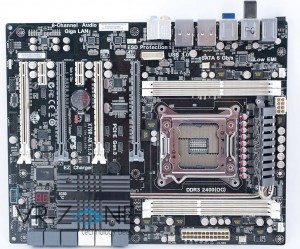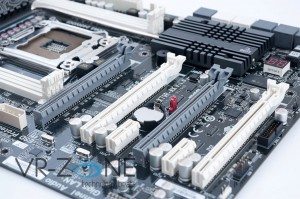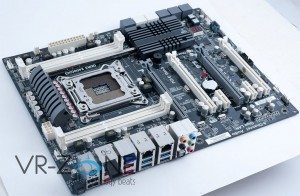ECS’s X79R-AX Black Series for your eyes only… for now
Andy Ruffell / 13 years ago
Recently, pictures of ECS’s top-notch high-end desktop motherboard were presented: the new LGA2011 supporting X79R-AX Black Series.
Pretty much every manufacturer will launch at least one X79 motherboard at the same time as Intel’s Sandy Bridge-E processors, the same can be expected for this one. To get onto the details, this board is aimed directly at the avid gamesr and overclockers, so this won’t be priced for your average family computer.
Powered by a 14-phase VRM, the X79R-AX features a total of eight DDR3 DIMM slots, four on each side for a support of up to 32 GB of quad-channel memory. Featuring four PCI-Express 3.0 x16 and the ability to use a 4-way SLI or Crossfire configuration, these four slots can be powered in the following configuration: x16/NC/x16/NC; x16/NC/x8/x8; x8/x8/x8/x8. Other than these four, you also get two PCI-Express x1, we then see the disappearance of the rather old by now PCI Legacy.
For your storage, you’ll get a total of 12 internal SATA and two eSATA, with speeds unknown, we can only guess about the number of 3Gbps and 6Gbps (if we base our guess on the colour only we could get anything from eight 6Gbps and four 3Gbps, or vice-versa). What is known at least is that the eSATA will run at 6Gbps.
Using TI-made USB3.0 controllers, which prove to be rather cost-effective, you will find four of these on the rear I/O and two standard internal header. A Realtek-made CODEC chip is in control of the 8-channel HD audio with a optical SPDIF through a TOSLINK connector. For connectivity you get a Realtek 8111E chip driving two gigabit Ethernet, a bundled Bluetooth dongle, and what may well be a Wireless N USB adapter.
As stated above, this board is clearly aimed at gamers and overclockers, and has what is needed to get the best out of it, with a CMOS-reset button on the rear panel, diagnostic numerical display, diagnostic LEDs can be found all around it as well, consolidated voltage manual measurement points and a thermometric strip over the chipset heatsink that gives an approximate analog temperature reading. The chipset and VRM heatsink are united by a 6mm think heat-pipe and a power and reset button can be found as well. Another thing we can easily guess is the UEFI firmware inlcuded.






















